written and photographed by Mary L. Peachin
Nov 2004, Vol. 9 No. 2
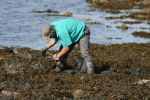 This arm of the frigid Atlantic pulsates tides twice daily. Embraced by cliffs, and fringed by salt marshes, the land is the Canadian cradle of European settlement. Unrivaled, its awesome ebb and flow powers all life in the bay. This is Fundy, Bay of Giant Tides.? Michael Burzynski
This arm of the frigid Atlantic pulsates tides twice daily. Embraced by cliffs, and fringed by salt marshes, the land is the Canadian cradle of European settlement. Unrivaled, its awesome ebb and flow powers all life in the bay. This is Fundy, Bay of Giant Tides.? Michael Burzynski
Autumn is clear and crisp along the Fundy Trail, the landscape a colorful kaleidoscope of brilliant orange and red foliage. Opaque brown waters of the Bay of Fundy rise from 22 to 30 feet during the full moon.
The Bay’s oblong geography creates a natural phenomenon, one that builds tides as high as 50-feet. Every six hours, bores and rip tides force powerful, clashing currents. Life in New Brunswick?s Bay of Fundy revolves around tides, those that dictate the seafarer?s way of life.
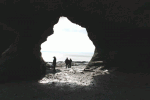 “Le mascaret”, as it is called, reverses the flow of St. John’s Riv er where Fundy’s salt water collides with fresh water in the river near downtown Saint John.
“Le mascaret”, as it is called, reverses the flow of St. John’s Riv er where Fundy’s salt water collides with fresh water in the river near downtown Saint John.
Hardcore kayakers wait patiently for high tide tucked behind Split rock’s calm water, while power boats have to wait. They require a slack tide to prevent the currents from sweeping them into the river’s bank.
Jet boat drivers, Baxter Stuart and Mo Richard, count on 600 turbos of horsepower to run the Falls. They don’t have to be concerned about becoming trapped in swirling eddies. Diving harbour seals feed on smelt and striped bass not far from the shoreline pulp and wood chip mills under Reversing Falls bridge.
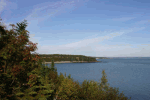 A real ecological treasure in Saint John is Irving Nature Park. Its 600 acres showcase a rich marine ecosystem of mud flats, salt marshes, volcanic rock beaches, and forest. There are eight hiking trailheads along the unpaved four-mile loop winding through red spruce, balsam fir and yellow birch Acadian forest. Autumn’s purple asters are waning; wild berries are ripe for picking.
A real ecological treasure in Saint John is Irving Nature Park. Its 600 acres showcase a rich marine ecosystem of mud flats, salt marshes, volcanic rock beaches, and forest. There are eight hiking trailheads along the unpaved four-mile loop winding through red spruce, balsam fir and yellow birch Acadian forest. Autumn’s purple asters are waning; wild berries are ripe for picking.
Atlantic Canada’s New Brunswick enjoys a rich history. The Mi?kmag and Maliseet were the first inhabitants of the small southeastern province. Samuel de Champlain stepped ashore on St. John the Baptist day, June 24,1604. He named his landing Saint John, a city that has evolved as the anchor for the Bay of Fundy. Almost a century later, during the American Revolution of 1783, 14,000 American British (Loyalists) migrated to the city. These immigrants prospered by establishing a thriving lumber and ship building industry. This region would become the gateway to the Bay of Fundy.
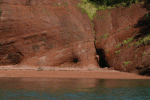 Saint John’s city market, built in 1762, is still bustling. The congregation of St. John Stone Anglican church, founded in 1825, shipped quarry rock from England for their building. Across the street, Shaarei Zedek Jewish synagogue embraces a blending of cultures dating back to 1867. In the late 1800’s, wooden ships became obsolete, but Saint John remained a major seaport.
Saint John’s city market, built in 1762, is still bustling. The congregation of St. John Stone Anglican church, founded in 1825, shipped quarry rock from England for their building. Across the street, Shaarei Zedek Jewish synagogue embraces a blending of cultures dating back to 1867. In the late 1800’s, wooden ships became obsolete, but Saint John remained a major seaport.
Today, 85 percent of New Brunswick’s 27,834 square miles are forested. 720,000 residents live in three major cities: Saint John, Moncton,and its capital, Fredericton. Cormorant and herring and ring-billed gulls perched like guards on the jetty watching us follow kayak guide Michael Carpenter out of St. Martins harbour into Quaco Bay. Thirty-seven miles across the Bay of Fundy, we could see Nova Scotia on the horizon.
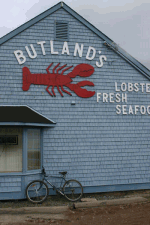 Paddling around an outcropping, we viewed stunning red sandstone cliffs. After a brief stop to peer into St. Martins cave, we encountered choppy water as waves clashed with the outgoing current. Making our way through the waves, our next turn brought views of grey cliffs. River deposits, dating back 300 million years, changed the color of the cliffs from red to grey.
Paddling around an outcropping, we viewed stunning red sandstone cliffs. After a brief stop to peer into St. Martins cave, we encountered choppy water as waves clashed with the outgoing current. Making our way through the waves, our next turn brought views of grey cliffs. River deposits, dating back 300 million years, changed the color of the cliffs from red to grey.
Between 1803 and 1919, St. Martin?s thriving lumber industry built 500 ships. Today, the city is a bedside community for Saint John workers, and its welcomes visitors exploringthe Fundy Trail.
Mist and fog shrouded our eco-adventure along the six-and-a-half Fundy Trail Parkway. Routes for cars and bicycles crossed footpaths; all leading to pristine beaches along the water’s edge, or tumbling waterfalls, and towering pre-Cambian rocks of red sandstone.
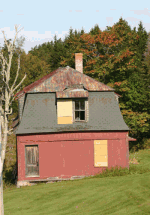 The Fundy interpretive center is located in what was historically the 20-family community of Salmon River. Built in early 1900’s, logs from the pulp mill flowed into the Bay, the launching point for lumber ships. Pejepscot Paper Company operated three sawmills complete with electricity and a school from 1840-1933. When the mill caught fire in 1933, about the same time as the invention of the automobile, the community steadily declined untilit folded in the 1950’s.
The Fundy interpretive center is located in what was historically the 20-family community of Salmon River. Built in early 1900’s, logs from the pulp mill flowed into the Bay, the launching point for lumber ships. Pejepscot Paper Company operated three sawmills complete with electricity and a school from 1840-1933. When the mill caught fire in 1933, about the same time as the invention of the automobile, the community steadily declined untilit folded in the 1950’s.
Driving through Fundy Park thick fog reduced visibility to a mere 50-feet. Fall foliage bordered harvested fields, crystal blue lakes were interspersed with coastal views. We backtracked several days later to relish the beauty of this landscape, the one we missed seeing because of fog.
The first remote lighthouse on New Brunswick?s rugged coastline was built overlooking Cape Enrage in 1848. Dramatic tidal changes along a shoreline barrier reef sank numerous ships.
Sculpted by the world’s highest tides (46 feet), conglomerate formations (hardened rock, sand, and mud silt) attract 200,000 summer visitors yearly to Hopewell Rocks Exploration Site. Numerous monoliths created by clashing continental shelves were carved by melting glaciers approximately 350 million years ago. Considered a marine wonder, Hopewell Rocksis the Fundy Trail’s most popular attraction.
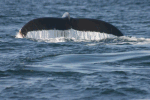 The Site is an Atlantic flyway for the semi-palmated sandpiper and plover, short-bill dowicher along with permanent resident flocks of Great blue herons, cormorants, and other salt marsh shore birds. More than three miles of trails and staircases (to the beach during low tide only) wind through cedar forest, red European blooming mountain ash, and flowering rosehips. The Atlantic right whale and white-side dolphin have been occasionally sighted from the shoreline.
The Site is an Atlantic flyway for the semi-palmated sandpiper and plover, short-bill dowicher along with permanent resident flocks of Great blue herons, cormorants, and other salt marsh shore birds. More than three miles of trails and staircases (to the beach during low tide only) wind through cedar forest, red European blooming mountain ash, and flowering rosehips. The Atlantic right whale and white-side dolphin have been occasionally sighted from the shoreline.
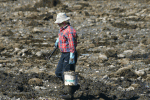 St. Andrews by the Sea is three hours south on the Fundy Trail. The city is Canada’s oldest resort town. In 1604, French explorers sailed into Passamaquoddy Bay creating what they called Acadie, a new territory on the Ste. Croix River.
St. Andrews by the Sea is three hours south on the Fundy Trail. The city is Canada’s oldest resort town. In 1604, French explorers sailed into Passamaquoddy Bay creating what they called Acadie, a new territory on the Ste. Croix River.
Danger! Mare’es! An elderly clam digger waited in his beaten truck for the incoming tide, “it’s easier to dig clams up on an incoming tide.” At low tide, a caravan of cars crossed the ocean floor of Passamaquoddy Bay. All of us were headed to Minister’s island for a tour of Covenhoven, the 500-acre summer residence of Sir William Van Horne. Chief engineer, and later, President of Canadian Pacific railway builder, Van Horne left a landmark for visitors to St.Andrews.
His estate has the largest barn in Canada, a pool built of shoreline rocks, and antiques from the past.
 Thanks to the generosity of John and Lucinda Flemer, St. Andrews is home to Kingsbrae Garden, one of Canada’s finest examples of horticultural. Its 27-acres include 2000 varieties of trees, shrubs, plants, and flowers. Some of its many gardens include the White, Rose, Knot, Perennial, and Cottage. Kids can get lost in a dense cedar shrub maze, others can marvel two ponds and streams, vegetable and herb gardens.
Thanks to the generosity of John and Lucinda Flemer, St. Andrews is home to Kingsbrae Garden, one of Canada’s finest examples of horticultural. Its 27-acres include 2000 varieties of trees, shrubs, plants, and flowers. Some of its many gardens include the White, Rose, Knot, Perennial, and Cottage. Kids can get lost in a dense cedar shrub maze, others can marvel two ponds and streams, vegetable and herb gardens.
The Algonquin Golf Course and Academy is best known for its back nine holes along Passamaquoddy Bay. The Thomas McBroom-designed 6,909, par 72 course has a woodland front nine. The course offers scenic views, is sporting, and great fun for the recreational golfer. We left the course and made a quick dash to the wharf for one of St. Andrews most popular activities, a whale watching trip.
The state of Maine was on the starboard horizon of the M/V Quoddy Link. The catamaran cruises a 30-mile radius around the scenic waters of Passamaquoddy Bay. We motored through Letite passage, a narrow channel where Passamaquoddy and Fundy Bays converge; creating strong eddies and rip tides.
Puppy dog-faced Harbor seals and the larger and less common grey seal slept on the lava rocks of Mohawk Island. Cormorants dipped into the water, an eagle soared above. The boat headed to waters south of The Wolves, a series of five islands. We began searching the horizon for a “blow”, the hot air from the whale’s lungs.
Atlantic white-sided and harbor dolphins swam with us racing along the bow of the boat. Soon we were in awe of dozens of finback (second in size to the Blue) and 50-foot humpback whales.
Leaving St. Andrews and the Canadian Pacific?s Fairmont Algonquin resort, we continued south toward the US. We made a brief stop in St. Stephen, Canada?s chocolate town. In 1873, James and Gilbert Ganong added candy to boost sales in their grocery store. A museum now operates in the original factory; a nearby state-of-the-art factory still produces chocolate and jellybeans.
Returning north to Saint John, we detoured off the highway to catch a ferry to Deer Island. While the 10-mile island has been inhabited since 1770, it is only home to 1000 residents.
Each day, red oak and maple, sumac and burning bush hardwoods turned brighter shades of red. Deciduous leaves of sugar maples, birch, and aspen turned to yellow and orange, the white ash added purple. A rainbow of color blended with green cedars and other evergreens. And twice a day, the gravitational pull of the moon created the same incredible ebbs and flow of the tides in the Bay of Fundy.
If you go:
800.561.0123 or www.TourismNewBrunswick.com Bay of Fundy, 866.59Fundy or www.highest-tides.com
Where to stay:
Inn on the Cove and Spa 1371 Sand Cove
Rd. Saint John 877.257.8080 ross@innonthecove.com or www.innonthecove.com A historic five-room turn-of-the-century accommodation conveniently located midway between St. John and Irving Park.
St. Martins Country Inn 303 Main Street 506.833.4534 800.565.5257 or www.stmartinscountryinn.com, St. Martins. Myrna and Al LeClair’s inn is an 1857 shipbuilder?s villa on the shore of Fundy.
Innisfree Bed @ Breakfast 506-734-2559 www.innisfreebandb.com. Jerome and Anna Beaumont?s inn is conveniently located near Hopewell Rocks.
The Fairmont Algonquin St. Andrews by the Sea 506.529.8823 www.fairmont.com
St. Andrews by the Sea’s 234-room Tudor-styled Fairmont Algonquin Hotel dates back to 1883. While built by an American, it has long been a flagship property of the Canadian Pacific Railway Company. Shadow Lawn Inn, Rothesay 800.561.4166, 506.847.7539 or www.shadowlawninn.com. A Victorian inn built in 1870 as a summer estate for department store owner James F. Robertson. Located in the town of Rothesay, it is a 10-minute drive from Saint John airport.
Where to eat:
Coastal Tides Family Restaurant 7 Beach
St.506-833-1997 Scrumptious seafood chowder, chocked full of lobster, haddock,
scallops, and clams make lunch here a favorite.
Weslan Inn 45 Main St., St. Martins 506.833.2351 www.weslaninn.com Chef Stephen Young and co-owner Nicholas Mitchell serve friendly and tasty meals in their Victorian home.
Le Chateau a Pape 506-855-7273 2 Steadman St. Moncton. Located on the Petticodiac river, Le Chateau a Pape has been serving fresh seafood, steak, and Acadian food since 1925. But, first a trip downstairs to the old wine cellar to select a vintage of your choice.
Inn on Frederick Rose Garden Room Joyce and Chef Jim Crouch serve upscale French cuisine. 877.895.4400 or www.innonfredrick.com
Rossmont Inn Gratiella and Chris Aerni 506-529.3351 www.rossmountinn.com. Exceptional regional cuisine featuring Malpeaque and hydopronic farmed oysters, fresh filet of haddock, and medallions of Sussex, New Brunswick red deer.
Ossie’s Lunch in Chamcook has been serving up New Brunswick best “take-out” lobster and clam rolls since 1957. Don’t miss this “blast from the past” on Route 1, (16 miles north of St. Andrews) 506.755.2758
Activities:
Irving Nature Park 506-632.7777 or www.ifdn.com New Brunswick Museum,
506.643.643.2338 or www.nbm-mnb.ca
Reversing Falls Jet Boat Rides 888.634.8987 or www.jetboatrides.com Fundy Trail Parkway 1.866.FundyTrail or www.fundy trailparkway.com
Hopewell Rocks Tidal Exploration Site 877.734.3429 or www.thehopewellrocks.ca St. Martins River Valley Adventures 888.871.4244 or www.rivervalleyadventures.com
Algonquin Golf Course and Academy 506.529.8823 or www.fairmont.com/golfalg
The Spa at the Fairmont 506.529.7195 www.fairmont.com
Quoddy Link Marine Whale and Wildlife Adventures 877.688.2600 or www.quoddylinkmarine.com
Seascape Sea Kayak Tour in St. Andrews and Deer Island 866.747.1884 or www.seascapetours.com.
Bruce Smith offers day trips for novices, and multi-day trips in the Bay of Fundy and 8-day trips in Newfoundland.
Kingsbrae Garden, St. Andrews 506-529-3335 or 866.566.8687 www.kingsbraegarden.com
The Chocolate Museum, St. Stephen 506.466.7848 or www.chocolatemuseum.ca
Getting there: Air Canada provides non-stop service from Toronto. Delta flies to Fredrickton (an hour drive) from Boston. Bangor, Maine is a three hour drive.
